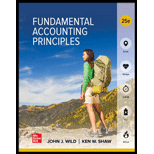
1.
Introduction:
Step-down method: The
Allocation of the service department’s cost to the consuming department and the predetermined overhead rates in the operating department.
2.
Introduction:
Direct method: Under the direct method, the overhead costs incurred by the supporting department are directly allocated to the operating department.
Allocation of the service department’s cost to the consuming department using the direct method and the predetermined overhead rate.
3.
a.
Step-down method: The overhead costs of supporting incurred by the supporting department are allocated to other supporting departments and also the operating department based on the allocation base.
The amount of overhead cost for the job using overhead rates computed in parts 1 and 2.
3.
b.
Step-down method: The overhead costs of supporting incurred by the supporting department are allocated to other supporting departments and also the operating department based on the allocation base.
The reason the step-down method is a better base for computing the predetermined rates than the direct method.
Want to see the full answer?
Check out a sample textbook solution
Chapter 4 Solutions
FUND.ACCT.PRIN.
- On January 2, Todd Company acquired 40% of the outstanding stock of McGuire Company for $205,000. For the year ending December 31, McGuire earned income of $48,000 and paid dividends of $14,000. Required: Journalize the entries for Todd Company for the purchase of the stock, share of McGuire Company income, and dividends received from McGuire Company. If an amount box does not require an entry, leave it blank. Jan. 2 Dec. 31 Dec. 31 0000 ☐☐☐☐☐☐arrow_forwardStatement of Owner's Equity Xavier Heffner owns and operates Heffner Advertising Services. On January 1, 2018, Xavier Heffner, Capital had a balance of $255,100. During the year, Xavier invested an additional $12,800 and withdrew $89,300. For the year ended December 31, 2018, Heffner Advertising Services reported a net income of $72,300. Prepare a statement of owner's equity for the year ended December 31, 2018. Use the minus sign to indicate negative values.arrow_forwardREQUIRED Use the information provided below to prepare the Statement of Changes in Equity of Sooraya Enterprises/Partnership for the year ended 28 February 2022. INFORMATION Extract from the ledger of Sooraya Enterprises on 28 February 2022 R Capital: Soo 450 000 Capital: Raya 350 000 Current a/c: Soo (01 March 2021) Current a/c: Raya (01 March 2021) Drawings: Soo Drawings: Raya The following must be taken into account: 30 000 CR 25000 DR 220 000 260 000 1. On 28 February 2022 the Profit and Loss account reflected a net profit of R 880 000. 2. Partners are entitled to interest at 12% p.a. on their capital balances. Note: Soo increased her capital contribution by R180 000 on 01 September 2021. The capital increase has been recorded. 3. The partners are entitled to the following monthly salaries for the first 6 months of the financial year: Soo R15 000 Raya R11 000 From 01 September 2021, the partners will be entitled to annual salaries of R144 000 each. 4. Raya is entitled to a bonus…arrow_forward
- Basic Income Statement The following are selected account balances of Rule Corporation at the end of the current year: Rule is subject to a 30% income tax rate, and shareholders own 800 shares of its capital stock. Required: Prepare the income statement for Rule.arrow_forwardForte Inc. produces and sells theater set designs and costumes. The company began operations on January 1, Year 1. The following transactions relate to securities acquired by Forte Inc., which has a fiscal year ending on December 31: Instructions 1. Journalize the entries to record these transactions. 2. Prepare the investment-related asset and stockholders equity balance sheet presentation for Forte Inc. on December 31, Year 2, assuming that the Retained Earnings balance on December 31, Year 2, is 389,000.arrow_forwardCurrent Attempt in Progress On January 1, Teal Mountain Corporation purchased a 30% equity interest in Lawton Company for $456,000. At December 31, Lawton declared and paid a $48,000 cash dividend and reported net income of $117,600. Prepare the necessary journal entries for Teal Mountain Corporation. (Credit account titles are automatically indented when the amount is entered. Do not indent manually. List all debit entries before credit entries. Record journal entries in the order presented in the problem.) Date Account Titles and Explanation Debit Creditarrow_forward
- The following are selected account balances of Rule Corporation at the end of the current year: Debit Credit Operating Expenses $3,200 Sales Revenue $17,780 Cost of Goods Sold 8,500 Interest Expense 790 Gain on Sale of Land 590 Rule is subject to a 30% income tax rate, and shareholders own 1,200 shares of its capital stock. Required: Prepare the income statement for Rule. RULE CORPORATION Income Statement For the Year Ended December 31, Current Year Other items: Earnings per sharearrow_forwardCompany A purchased 44% ($250,000) of Company b in common stock at an 8% discount. He paid $5,700 in commissions. At the end of the year Company A. should have an adjusted balance in his Company b. investment account of ______________ . a.Debit Investment $276,620 b.Investment Credit of $276,620 c.Debit to Investments of $304,780 d.Investment Credit of $304,780arrow_forward
 Intermediate Accounting: Reporting And AnalysisAccountingISBN:9781337788281Author:James M. Wahlen, Jefferson P. Jones, Donald PagachPublisher:Cengage Learning
Intermediate Accounting: Reporting And AnalysisAccountingISBN:9781337788281Author:James M. Wahlen, Jefferson P. Jones, Donald PagachPublisher:Cengage Learning Financial AccountingAccountingISBN:9781337272124Author:Carl Warren, James M. Reeve, Jonathan DuchacPublisher:Cengage Learning
Financial AccountingAccountingISBN:9781337272124Author:Carl Warren, James M. Reeve, Jonathan DuchacPublisher:Cengage Learning Individual Income TaxesAccountingISBN:9780357109731Author:HoffmanPublisher:CENGAGE LEARNING - CONSIGNMENT
Individual Income TaxesAccountingISBN:9780357109731Author:HoffmanPublisher:CENGAGE LEARNING - CONSIGNMENT





